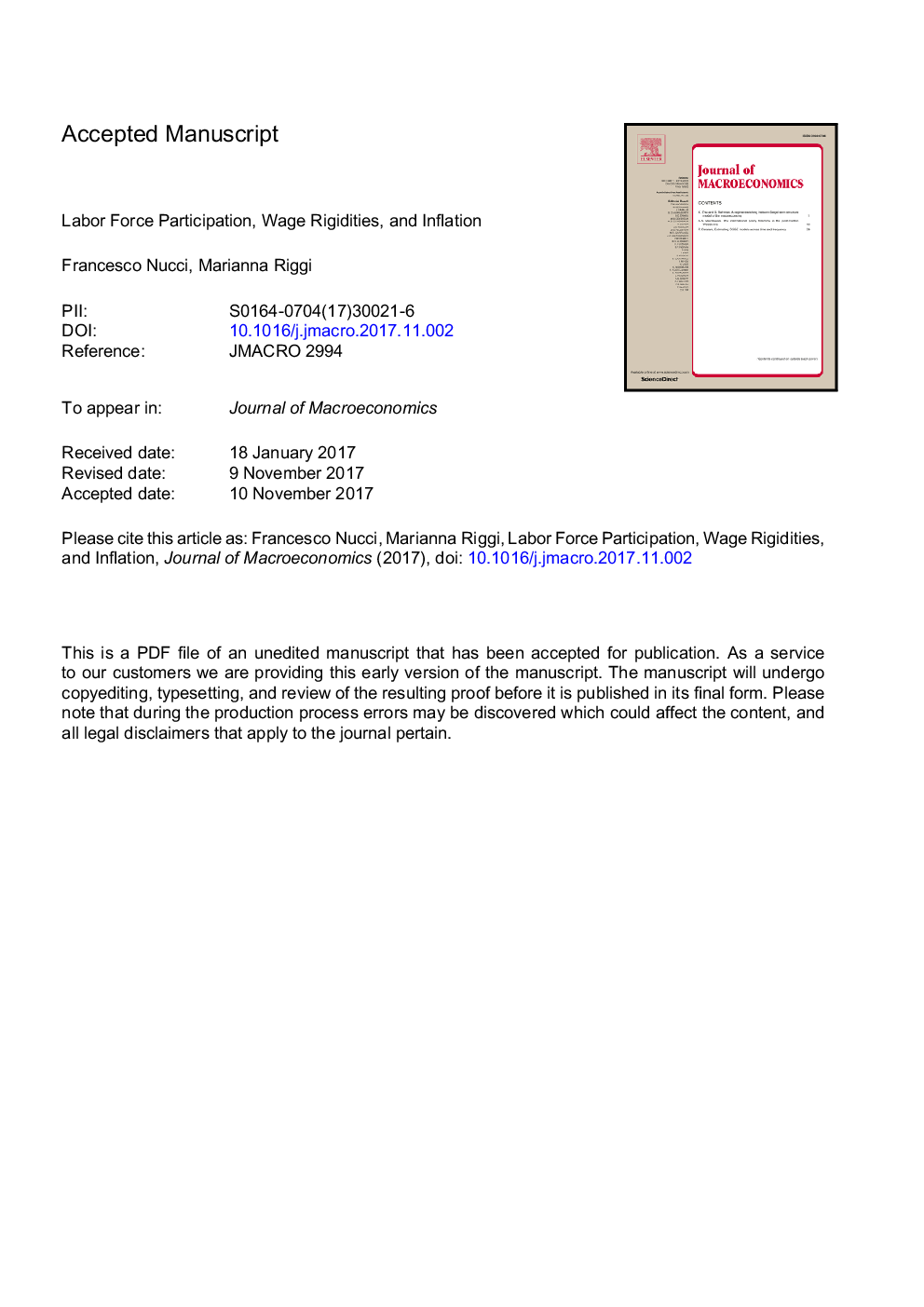| کد مقاله | کد نشریه | سال انتشار | مقاله انگلیسی | نسخه تمام متن |
|---|---|---|---|---|
| 7366900 | 1479216 | 2018 | 42 صفحه PDF | دانلود رایگان |
عنوان انگلیسی مقاله ISI
Labor force participation, wage rigidities, and inflation
ترجمه فارسی عنوان
مشارکت نیروی کار، استحکام دستمزدها و تورم
دانلود مقاله + سفارش ترجمه
دانلود مقاله ISI انگلیسی
رایگان برای ایرانیان
کلمات کلیدی
ترجمه چکیده
سقوط مشارکت نیروی کار ایالات متحده در طول رکود بزرگ، در مقایسه با افزایش موازی آن در منطقه یورو، کاملا متفاوت است. علاوه بر نیروهای ساختاری، نشان می دهد که عوامل چرخه ای نیز برای این الگوها در نظر گرفته شده است، زیرا نرخ مشارکت در ایالات متحده از زمان آغاز بحران و مقابله با بحران در منطقه یورو تقریبا غیرممکن است. ما این تحولات متنوع را با استفاده از یک مدل چرخه تعادلی تعادل عمومی، که تصمیمات مشارکت درونی را در چارچوب جستجو و تطبیق قرار می دهد، تحقق می بخشیم. ما نشان می دهیم که اضافه کارگر ؟؟ اثر ممکن است بیش از آنکه در معرض تخریب قرار گیرد؟ اگر سفتی حقوق و دستمزد مجاز باشد و / یا عادت در تنظیمات مصرف کنندگان، به اندازه کافی قوی باشد. پس از آن مشارکت نیروی متغیر نیروی کار برای تورم را به دست می آوریم و نتیجه ی زیر را می یابیم: اگر جنبش های درون سازمانی در مشارکت در بازار کار پیش بینی شده باشد، میزان رضایت از دستمزد واقعی تقریبا برای پویایی قیمت ها بی اهمیت می شود. در حقیقت، در طی رکود اقتصادی، فشارهای رو به بالا بر تورم که ناشی از عدم تعدیل دستمزد واقعی است، با تأثیر متضادی از رکود اقتصادی بیشتر در بازار کار، با توجه به مشارکت بیشتر در ارتباط با استحکام حقوق و دستمزد، جبران می شود.
موضوعات مرتبط
علوم انسانی و اجتماعی
اقتصاد، اقتصادسنجی و امور مالی
اقتصاد و اقتصادسنجی
چکیده انگلیسی
The fall in the US labor force participation during the Great Recession stands in sharp contrast with its parallel increase in the euro area. In addition to structural forces, cyclical factors are also shown to account for these patterns, with the participation rate being procyclical in the US since the inception of the crisis and countercyclical in the euro area. We rationalize these diverging developments by using a general equilibrium business cycle model, which nests the endogenous participation decisions into a search and matching framework. We show that the “added worker” effect might outweigh the “discouragement effect” if real wage rigidities are allowed for and/or habit in consumers' preferences is sufficiently strong. We then draw the implications of variable labor force participation for inflation and establish the following result: if endogenous movements in labor market participation are envisaged, then the degree of real wage rigidities becomes almost irrelevant for price dynamics. Indeed, during recessions, the upward pressures on inflation stemming from the lack of downward adjustment of real wages are offset by an opposite influence from the additional looseness in the labor market, due to the higher participation associated with wage rigidities.
ناشر
Database: Elsevier - ScienceDirect (ساینس دایرکت)
Journal: Journal of Macroeconomics - Volume 55, March 2018, Pages 274-292
Journal: Journal of Macroeconomics - Volume 55, March 2018, Pages 274-292
نویسندگان
Francesco Nucci, Marianna Riggi,
